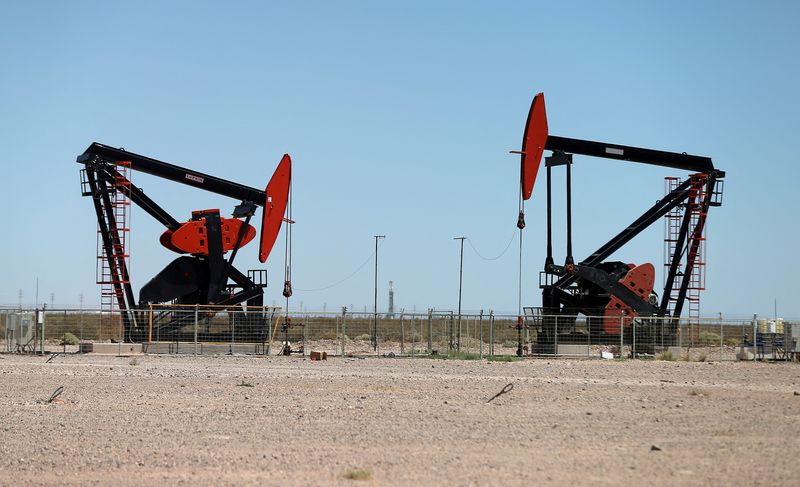Commodities
Oil prices set for weekly gain on U.S. growth and Middle East concerns


© Reuters. FILE PHOTO: Oil pump jacks are seen at the Vaca Muerta shale oil and gas deposit in the Patagonian province of Neuquen, Argentina, January 21, 2019. REUTERS/Agustin Marcarian/File Photo
By Alex Lawler
LONDON (Reuters) -Oil prices eased on Friday but remained on course for a second consecutive weekly gain, supported by positive U.S. economic growth and Middle East supply concerns.
The United States, the world’s biggest oil consumer, registered faster than expected economic growth in the fourth quarter, data showed on Thursday. Oil demand sentiment was also buoyed this week by China’s latest measures to boost growth.
futures were down 58 cents, or 0.7%, at $81.85 a barrel by 1227 GMT, having set its highest price so far this year with an intra-day peak of $82.57 in the previous session. U.S. West Texas Intermediate crude was down 74 cents, or 1%, at $76.62.
“The economy remarkably weathered the storm caused by past rate rises and it remains ebullient at the beginning of 2024,” Tamas Varga, of oil broker PVM, said of the United States, adding that China’s cut to the amount of cash reserves banks must hold was “another welcome development”.
Brent crude and the U.S. benchmark were set for weekly gains of 4.2% and 4.4% respectively. Both were on track for their biggest weekly increase since the week ending Oct. 13 after the start of the Israel-Hamas conflict in Gaza.
Prices slipped on Friday on hopes that oil shipping disruptions in the Red Sea could ease after Chinese officials asked Iran to help rein in attacks on ships by the Iran-backed Houthis or risk harming business relations with Beijing.
Still, previous interventions by U.S. and UK forces in the Red Sea did not prevent attacks, leading investors to price in continued disruption, said Yeap Jun Rong, a market strategist at IG in Singapore.
Supply concerns are evident in the structure of Brent futures, meanwhile. The premium of the first-month contract to the sixth rose to $2.58, its highest since November, indicating a perception of tighter prompt supply.
Oil was also boosted this week by a larger than expected drawdown in stockpiles and potential fuel supply disruption after a Ukrainian drone attack on an export-oriented oil refinery in southern Russia.
Commodities
Oil prices rise; U.S. crude inventories plunge, Russia-Ukraine truce eyed
Commodities
India’s Reliance to stop buying Venezuelan oil over US tariffs, sources say
Commodities
Oil prices climb on Venezuela supply worries

 Forex3 years ago
Forex3 years agoForex Today: the dollar is gaining strength amid gloomy sentiment at the start of the Fed’s week

 Forex3 years ago
Forex3 years agoUnbiased review of Pocket Option broker

 Forex3 years ago
Forex3 years agoDollar to pound sterling exchange rate today: Pound plummeted to its lowest since 1985

 Forex3 years ago
Forex3 years agoHow is the Australian dollar doing today?

 Cryptocurrency3 years ago
Cryptocurrency3 years agoWhat happened in the crypto market – current events today

 World3 years ago
World3 years agoWhy are modern video games an art form?

 Commodities3 years ago
Commodities3 years agoCopper continues to fall in price on expectations of lower demand in China

 Economy3 years ago
Economy3 years agoCrude oil tankers double in price due to EU anti-Russian sanctions























